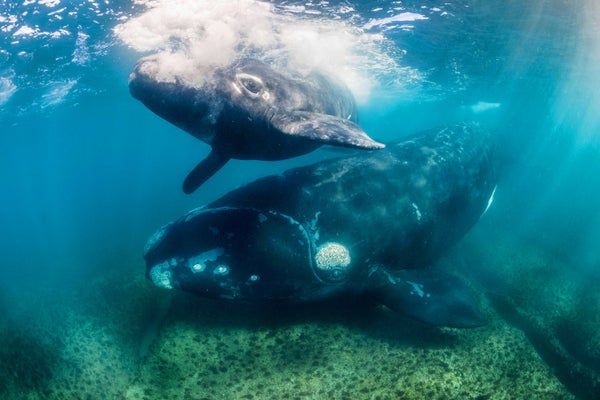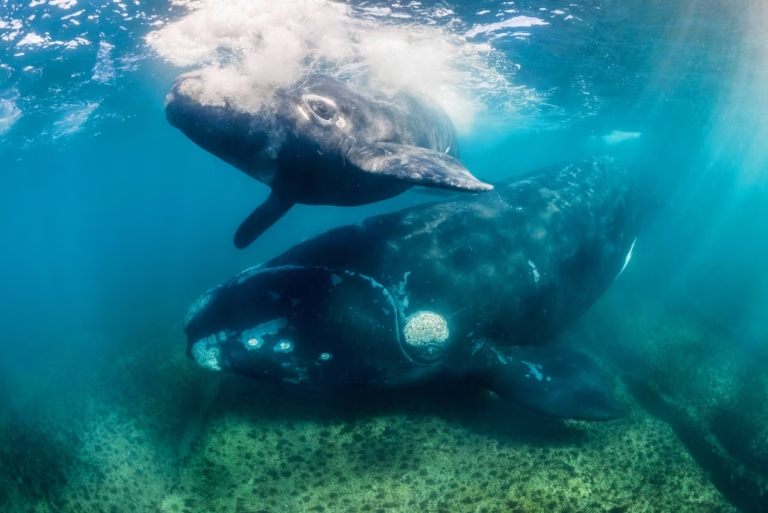December 31, 2024
4 minimum read
Some of these whales could live up to 150 years old – twice the age previously thought
Bowhead whales were known to live up to 200 years, but new research has found that southern right whales can live up to 150 years old if not hunted.

Southern right whale (Eubalaena australis) and its calf floated in the waters of Argentina’s Nuevo Bay.
Blue Planet Archive/Alamy Stock Photo
The following essay is reproduced with permission. ![]() The Conversation is an online publication covering the latest research.
The Conversation is an online publication covering the latest research.
Our new research published in the journal Science Advances shows that southern right whales can live well over 100 years, with 10% potentially living for more than 130 years. Some of these whales can live up to 150 years. This lifespan is almost double the 70-80 year lifespan traditionally thought.
North Atlantic right whales were thought to have a maximum lifespan of about 70 years. However, it turns out that the current average lifespan of this endangered species is just 22 years, and they rarely live past the age of 50.
About supporting science journalism
If you enjoyed this article, please consider supporting our award-winning journalism. Currently subscribing. By subscribing, you help ensure future generations of influential stories about the discoveries and ideas that shape the world today.
These two species are so closely related that just 25 years ago they were thought to be one species. Therefore, these two species are expected to have similarly long lifespans. We believe that the apparent differences in North Atlantic right whale lifespan are primarily due to human-induced mortality due to entanglement in fishing gear and collisions with ships.
We used photo identification of individual female whales over several decades to make these new age estimates. Individual whales can be identified from photographs each year. When they die, they are no longer “re-recognized” in photographs and disappear. Using these photos, scientists created what scientists call a “survival curve” by estimating the probability that a whale would disappear from the photographic record as it aged. From these survival curves, the maximum potential lifespan can be estimated.
Twenty-five years ago, scientists working with indigenous whalers in the Arctic showed that bowhead whales can live for more than 200 years. Their evidence included the discovery of the tip of a harpoon, not used since the mid-1800s, embedded in the blubber of a whale recently killed by traditional whalers. Analysis of proteins taken from the eyes of captive whales provided further evidence that whales are long-lived. Like right whales, before that analysis, researchers believed bowhead whales had a lifespan of about 80 years, making them the longest-living mammal known to humans.
In the years since this report, scientists have been trying to figure out what makes bowhead whales unique and allows them to live so long. But our new analysis of the longevity of two bowhead whale relatives shows that other whale species are potentially very long-lived as well.
why is it important
Understanding the lifespan of wild animals has a huge impact on how best to protect them. Animals with very long lifespans usually reproduce very slowly, and can take many years before the next birth. The life history of baleen whales, particularly the age at which females begin breeding and the spacing between calves, is strongly influenced by their potential longevity. Conservation and management strategies that are not planned accordingly are likely to fail. This is especially important given the expected impacts of climate change.
What is not known yet
There are also many other large whales to see, including blue whales, sei whales, humpback whales, gray whales, and sperm whales. Like bowhead and right whales, these were also nearly wiped out by whaling. Scientists currently think bowhead and right whales have a lifespan of about 80 or 90 years, but until data proves they can live much longer, we won’t believe that for bowhead and right whales. I believed it.
How long can these other whale species live? Industrial whaling finally ended in the 1960s, but old whales were eliminated from the world’s whale population. Although many whale populations are recovering, there is still not enough time for whales born after industrial whaling ended to reach old age.
It is possible, or even likely, that many other whale species will also turn out to be long-lived.
What other research is being done?
Other studies have found that the loss of older individuals from populations is a phenomenon that occurs in most large animal species. It reduces fertility in many species. Researchers also argue that this represents a true loss of culture and wisdom in animals, reducing their chances of survival in the face of changing conditions.
what’s next
We wanted to better understand how whaling has affected the number of older individuals in current whale populations and predict when the number of older individuals will recover to pre-whaling levels. I am. Preliminary results suggest that it could take another 100 years for whale populations to truly recover, even if the species is as abundant as it was before whaling.
For North Atlantic right whales, our research shows that even if populations are increasing, management measures in place are insufficient to prevent these whales from dying too young. I am.
of Research overview A short summary of interesting academic research.
This article was first published conversation. please read original article.

